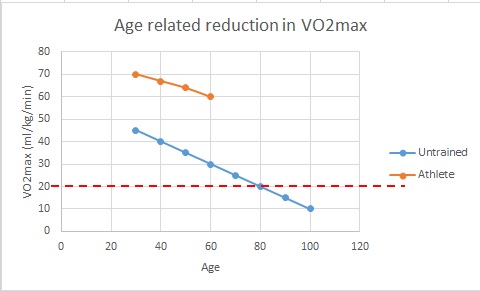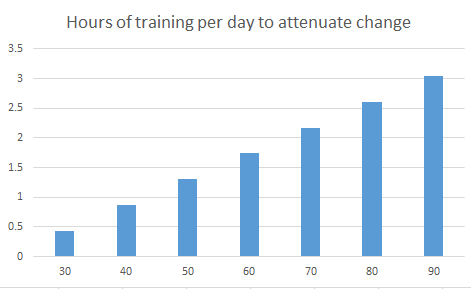How much exercise do we need to 'stay young'?
Alan Couzens, MS (Sports Science)
March 17th, 2014
The lady in the above commercial, Sister Madonna Buder, represents everything that this post is about: Longevity in (& through) sport!
As Gordo points out in this blog , the amount of exercise required for health is far less than what most 'serious athletes' are doing in their 'competitive years'. In fact, some have argued that the amount of exercise that many endurance athletes are doing is decidedly unhealthy, as Dr. Larry explores in another EC article. No, if we are to be honest with ourselves, many of us, 'keep it rolling' in our 30's & 40's not so much for true health or a maintenance of true day to day functional fitness but more the fear of re-stacking those 'freshman 15 or 20 or 30...' or, for those at the top of the training spectrum, for fear of 'losing it'.
What do I mean by 'losing it'? Losing the plot? Well, that's certainly another issue that the exercise-addicted can face :-) but no, here I'm talking about that, oh so precious, word - fitness!
What does it mean to be fit? Our collective perspective may be a little off here. For some of us, if we're not in sub 9hr Ironman shape, we're not fit(!) but I think we could all generally agree that maintaining the function of our younger selves is a high priority.
Before we get into just what it takes to maintain the same function as our 'younger selves' through the years, it's worth exploring how, for the very fit, our perspective on just what it means to be fit can get a little 'off': If you're a mid-packer in your 30's and 40's, you can, to a certain extent, 'out-train' aging, i.e. the positive gain in fitness that you can get from progressively ratcheting up your commitment to training over the years can exceed the rate of normal fitness loss through aging. However, if you're already very fit, if you're racing elite or already on the AG podium in your 30's and 40's, chances are good that towards the end of that time frame, in spite of training as much or more than your 'younger self', things are going to start to slow down a bit. Saying that this can be a bit of a tough pill to swallow for somebody who has built a large portion of their life around becoming a faster athlete is an understatement.
Frankly, the above scenario leads to a lot of the speedy athletes giving the sport away at this point. Or, maybe 'fading away' might be a better term. It begins with, I'm just going to train unstructured & 'do it for fun' and then when they figure racing 'slow' isn't any fun they just fall away from the sport all together. Nothing is sadder. This completely misses the true value of sport, the value of an ongoing commitment to continue to be competitive within your age group for every age group.
And why? Because the later age groups are the ones that really count! While the difference between a midpacker VO2max of 50 and an AG podium VO2max of 70 might not mean a whole lot in terms of your everyday functional fitness as a 40 year old, the difference in that same 20ml/kg gap, from 25 to 45ml/kg will mean a whole lot when you start creeping up on your 60's, 70's and 80's. It's the difference between being 'fit' or being 'feeble' - the difference between saying "sure we can walk half way across the city rather than waiting for the next bus", "Sure I'll come on a hike with you this weekend", "No problem, I can lift that", "yes, little Johnny, Grandpa would love to come run around the backyard with you." and, perhaps most important of all "yes, I'm young & fit enough to beat this." Whatever, 'this' may be, your chances are exponentially better if you're going into it not just healthy but fit! Percy Cerutty wrote a book - "Be fit or be damned!" (a book you should read, by the way). Not to put too fine a point on it, from my perspective, he was spot on.
So, let's put a number on this level of truly 'functional' fitness.. The bulk of studies that have looked at the question of average young (collegiate) guy/girl fitness have found VO2max values in the range of 35-45 ml/kg/min. In our world, nothing too special, something in the range of 23-30 mins for a 5K. But, according to the extensive data from the Cooper institute's studies, a level of fitness that is found in fewer than 2% of the over 60 population!
This natural drop off in aerobic capacity with age is shown in the chart below.

The studies that have investigated this question have tended to find a pretty uniform drop of 5ml/kg/min per decade when no intervention (i.e. exercise) is made. At that consistent drop off rate, you can do the math to see where things are headed. It's only a matter of a few decades before fitness (& life) is significantly compromised. While it's hard to come up with a definitive fitness requirement to 'sustain life', the dashed line on the chart coincidentally corresponds with the equivalent VO2max of what climbers call "the death zone", i.e. altitudes of greater than approx. 8000m of elevation. I will leave it to you to determine whether the intersection of the typical fitness decline and average life expectancy at this point is truly coincidental.
On a cheerier note, when a high (competitive) level of exercise is 'taken' throughout the course of an athlete's life, as in Heath et al.'s 1981 study (data referenced as the orange line in the chart above), subjects still exhibit a decline but..
- They are starting from a much higher point
- The decline is significantly attenuated
This fact is what prompted my tweet...
Always sad to see middle age athletes fall away from sport. The greatest challenges to health & fitness come in the later yrs. #PaceYourself
; Alan Couzens (@Alan_Couzens) February 10, 2014It's sadly ironic that our interest in exercise tends to be peak when we are at the age when we are naturally the most fit, when in actuality, if we are looking to even come close to maintaining the fitness of our younger selves, our investment in exercise must significantly increase as the years progress.
So how much are we talking here? While there is significant individual variation in training response, as discussed here, a 'ballpark' aerobic training response would be in the range of 0.5ml/kg/min per 100 hours of training. In practice, this means that your average 30-40yo athlete, can attenuate the normal 5ml/kg/min decline for the decade with a relatively meager exercise investment of 100hrs per year. However, for the 60 year old, looking to maintain a similar level of fitness, the news isn't quite so good. Carrying the math forward, preventing the decline here would take ~475hrs of aerobic activity for the year! Is it any wonder that only 2% of the over 60 population have this level of fitness? Based on these calcs, the level of aerobic exercise (hrs/day) needed to maintain, across the decades, is shown below...

At the risk of exceeding my comfortable domain of giving training advice to the less comfortable domain of life advice, in my opinion, a key life balance goal as you develop professionally and improve your $/hr should be to use that increased $/hr, not to buy more - not to have a bigger house or a fancier car, but to free up some more hours in your day for physical training in the interests of maintaining your long term health and functional fitness!
While a 2+hrs of training per day may be far from 'the norm' for your typical 70 year old, it does happen. These 70 year olds are the same ones that inspire us every year by having the capacity to finish the Hawaii Ironman. As Sister Buder shows us, maybe being a little unusual isn't such a bad thing.
#PaceYourself
AC
TweetDon't miss a post! Sign up for my mailing list to get notified of all new content....
